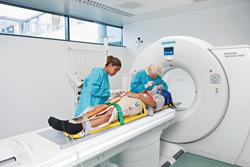
At RSNA, Siemens Healthcare is unveiling the Somatom Definition Edge the first single-source computed tomography (CT) to use Siemens recently developed Stellar Detector. In routine examinations, structures up to 0.3 mm are visible, and image sharpness may potentially be improved.
November 28, 2011 – At the 97th Scientific Assembly and Annual Meeting of the Radiological Society of North America (RSNA), from November 27 to December 2 in Chicago, Siemens Healthcare is unveiling the Somatom Definition Edge – the first single-source computed tomography (CT) to use Siemens’ recently developed Stellar Detector. In routine examinations, structures up to 0.3 mm are visible, and image sharpness may potentially be improved. Boasting a rotation speed of 0.28 seconds, the Somatom Definition Edge is Siemens’ fastest single-source CT scanner, acquiring up to 23 centimeters per second – which may enable a physician to perform a customary thorax-abdomen examination in approximately two seconds and potentially eliminate the need for patient breath-holding during a scan. Siemens also has developed a new Dual Energy mode for the Somatom Definition Edge. In Dual Energy images, two different tube voltages are generated to help enable recognition of different tissue types.
The Somatom Definition Edge employs the new TrueSignal technology of the Stellar Detector, which for the first time integrates the electronic detector components into the photodiode. With the aid of TrueSignal technology, Stellar may significantly reduce electronic noise and potentially improve the signal-to-noise ratio of the images. To date, a spatial resolution of up to 0.33 mm has been possible with Siemens single-source CT scanners. However, in critical cases like cardio-vascular examinations or in emergency diagnostics, every additional visible micrometer can be significant. The examination of adipose patients further illustrates how Stellar's signal processing may potentially open up new possibilities in clinical practice. An obese patient can attenuate the signal from the X-ray tube to such an extent that many CT systems can no longer generate images suitable for diagnostic purposes. Even where signals are weak, TrueSignal technology may enable the generation of images with contrast levels that the physician may be able to use for diagnostic purposes.
Increased speed in single-source CT
A major challenge in CT scanning involves maintaining good spatial resolution at high gantry rotation speeds. With patients who cannot remain still for extended periods, or with fast-moving organs such as the heart, the shortest possible scanning time minimizes image motion artifacts. For this reason, the Somatom Definition Edge features a newly developed gantry that requires just 0.28 seconds per rotation, enabling a very high spatial resolution of 142 ms. Additionally, the scanner allows a pitch of 1.7, equivalent to an acquisition speed of up to 23 centimeters per second.
Dose-optimized dual energy for single-source CT
Until now, Dual Energy examinations with single-source devices required the tube voltage to be changed several times during a single scan, which deteriorates image quality, as fewer than half the number of projections are available for each energy level. Since changing the voltage while the current is being modulated is also impossible, the current must be permanently set for the duration of the scan. This results in a dose level several times higher than is seen with a customary single-source scan.
Since dose reduction is a top priority for Siemens, the Somatom Definition Edge introduces a new scanning technique into single-source CT examinations. During a Dual Energy examination with the new Siemens CT scanner, two scans are performed in succession with different energy levels, with each scan using only about half the dose applied in normal mode. Together, the two scans deliver the original dose required. Also, since the voltage in each scan is fixed, all dose-reducing methods can be used. Of particular note is Care Dose4D, a fully automatic radiation exposure control system that adjusts the dose in real time according to the area of the body being scanned; Care Dose4D is therefore capable of reducing overall dose levels. The Somatom Definition Edge also uses sinogram affirmed iterative reconstruction (SAFIRE) – a rapid iterative reconstruction method for CT data that may also help reduce dose levels. Thus, Dual Energy images may be generated using a single-source system without exposing the patient to unnecessarily high radiation levels.
For more information: www.siemens.com/healthcare
